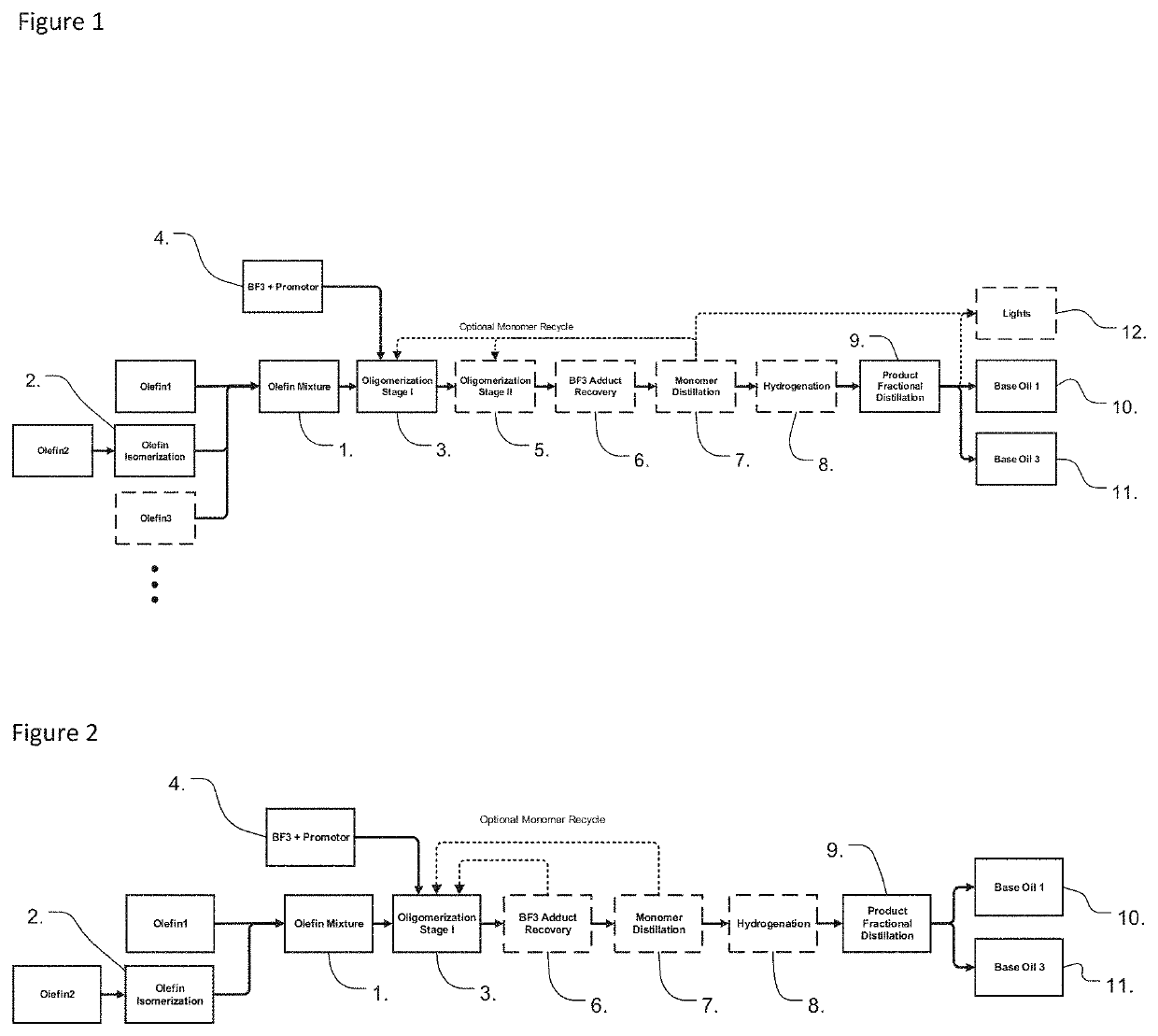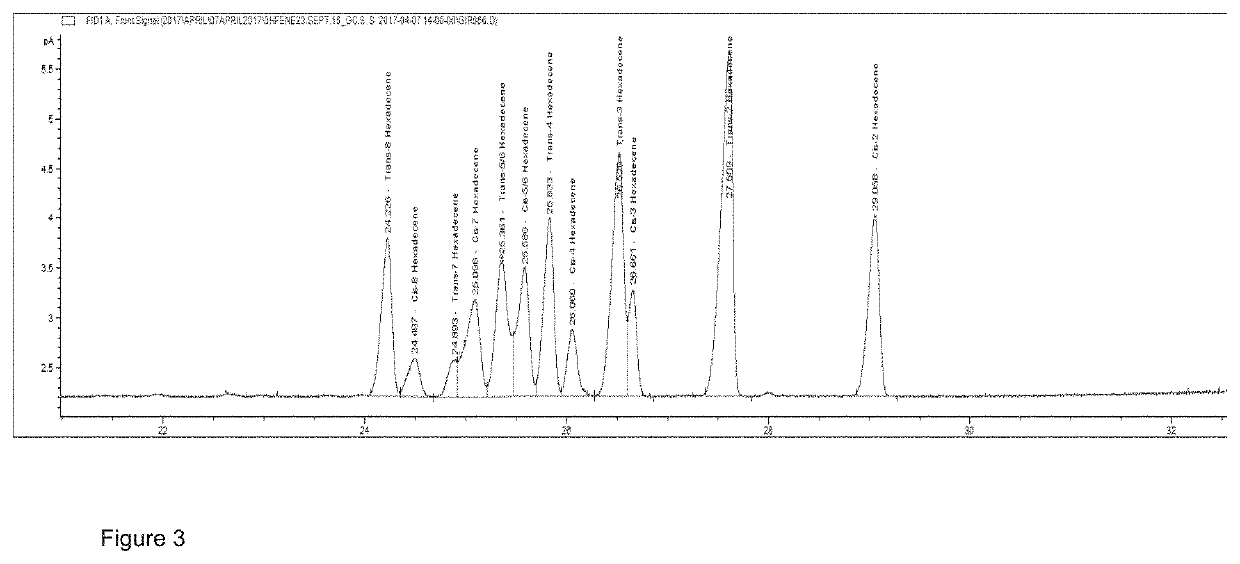Base oils and methods of making the same
a technology of base oils and oligomers, which is applied in the field of isoparaffin oligomers, can solve the problems of high cost of polyalphaolefin derived from 1-decene, production of significant quantities of cross-oligomers that do not have the desired properties, and still do not completely remove the requirement for providing decen
- Summary
- Abstract
- Description
- Claims
- Application Information
AI Technical Summary
Benefits of technology
Problems solved by technology
Method used
Image
Examples
example 1
[0099]Obtained 1-Hexadecene with less than 8% branched and internal olefins. Isomerized 1-hexadecene using a Pd on alumina catalyst in a batch slurry reaction at 200° C. for 4 hours to obtain linear internal olefin (LIO) with an average double bond position of 1.76. An olefin mixture comprised of 70% of said isomerized hexadecene and 30% of 1-tetradecene was oligomerized. The oligomerization reaction used between 1 and 10 PSI of BF3 with a co-catalyst composition of BuOH and BuAc. The reaction was held at 100° C. during semi continuous addition of olefins and co-catalyst. The unreacted monomer was then distilled off and the residue was hydrogenated to a Br index (ASTM D2710) of less than 1000 mg Br / 100 g. A following distillation was used to remove the dimer from the residue to obtain a base oil with a KV100 of 4.21 cSt, with a viscosity index of 128, with a −33° C. pour point (ASTM D97), a dynamic viscosity at −35° C. of 1889 cP (ASTM D5923), and a Noack volatility (ASTM D5800) of ...
example 2
[0100]Obtained 1-Hexadecene with less than 8% branched and internal olefins. Isomerized 1-hexadecene using a Pd on alumina catalyst in a batch slurry reaction at 260° C. for 4 hours to obtain linear internal olefin (LIO) with an average double bond position of 2.54. An olefin mixture comprised of 70% of said isomerized hexadecene and 30% of 1-tetradecene was oligomerized. The oligomerization reaction used between 1 and 10 psi of BF3 with a co-catalyst composition of BuOH and BuAc. The reaction was held at 100° C. during semi continuous addition of olefins and co-catalyst. The unreacted monomer was then distilled off and the residue was hydrogenated to a Br index (ASTM D2710) of less than 200 mg Br / 100 g. A following distillation was used to remove the dimer from the residue to obtain a base oil with a KV100 of 4.24 cSt, with a viscosity index of 120, with a −45° C. pour point (ASTM D97), a dynamic viscosity at −35° C. of 2005.5 cP (ASTM D5923), and a Noack volatility (ASTM D5800) of...
example 3
[0101]Obtained 1-Hexadecene with less than 8% branched and internal olefins. Isomerized 1-hexadecene using a Pd on alumina catalyst in a batch slurry reaction at 260° C. for 4 hours to obtain linear internal olefin (LIO) with an average double bond position of 3.15. An olefin mixture comprised of 70% of said isomerized hexadecene and 30% of 1-tetradecene was oligomerized. The oligomerization reaction used between 1 and 10 psi of BF3 with a co-catalyst composition of BuOH and BuAc. The reaction was held at 100° C. during semi continuous addition of olefins and co-catalyst. The unreacted monomer was then distilled off and the residue was hydrogenated to a Br index (ASTM D2710) of less than 200 mg Br / 100 g. A following distillation was used to remove the dimer from the residue to obtain a base oil with a KV100 of 4.24 cSt, with a viscosity index of 120, with a −45° C. pour point (ASTM D97), a dynamic viscosity at −35° C. of 2005.5 cP (ASTM D5923), and a Noack volatility (ASTM D5800) of...
PUM
| Property | Measurement | Unit |
|---|---|---|
| Pour Point | aaaaa | aaaaa |
| Pour Point | aaaaa | aaaaa |
| viscosity index | aaaaa | aaaaa |
Abstract
Description
Claims
Application Information
 Login to View More
Login to View More - R&D
- Intellectual Property
- Life Sciences
- Materials
- Tech Scout
- Unparalleled Data Quality
- Higher Quality Content
- 60% Fewer Hallucinations
Browse by: Latest US Patents, China's latest patents, Technical Efficacy Thesaurus, Application Domain, Technology Topic, Popular Technical Reports.
© 2025 PatSnap. All rights reserved.Legal|Privacy policy|Modern Slavery Act Transparency Statement|Sitemap|About US| Contact US: help@patsnap.com



